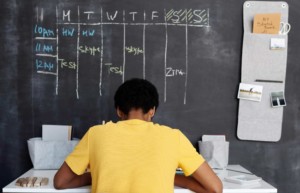Should Teachers Share Formative Assessment Results in the Classroom?

Assessment in our schools is a HOT topic. This is largely because when people hear assessment, they think testing, but assessment is SO much more. No one wants to see instructional time overtaken by extensive testing that seems to have little actual purpose on their educational journey. However, most of us understand that it is in fact important to understand what kids know and are able to do. Reality sets in, assessment is part of this.
So how do we change public opinion about assessment? They key will be showing what is done with assessment results. We have to prove that assessment, when embedded in the learning process can provide valuable information that enhances and personalizes the learning experience for students. A huge part of this is understanding and valuing the difference between the summative, end of semester, high stakes tests and those formative assessments that are truly embedded within lessons and are designed to to help guide student learning and teacher instruction.
In this blog post, Ron Drabkin, Vice President of Marketing at OpenEd raises an interesting question: Should Teachers Share Formative Assessment Results in the Classroom? The more that we use formative assessment to personalize learning and mastery tracking to support a competency-based environment the closer we will get to a truly personalized environment that supports growth, values individual interest and increases student opportunity for success. OpenEd is committed to creating resources and tools that support educators through this journey.
This post originally appeared on the Next Gen Learning blog.
Ron Drabkin
Formative assessments have come a long way. Most educators would agree that they are best practice, but historically, they have not been used in the classroom as much as one might think for the following reasons:
- Formative assessments need to be administered and graded, and when educators don’t have technology to assist with that, it is a lot of work.
- Prebuilt formative assessments need to be available and need to be aligned to Common Core State Standards, other standards, and textbooks.
As always in the classroom, solving one problem leads to new dilemmas. In this case, when a teacher has real-time feedback for his or her students on their formative assessment performance, the dilemma becomes sharing it. Should the results be shared? And should the results be shared on a big screen in the classroom so each student can see how everyone is doing? Tony Sanders, a teacher in Washington, D.C., would say, “Yes!”
Last year, Sanders taught juniors and seniors with learning differences. For his final exams this past spring, he did something unusual: he used formative assessments from OpenEd, creator of the world’s largest online library of standards-aligned resources for K-12 teachers (where I work), as the tests.
Here’s how it worked: Sanders assigned the students formative assessments from OpenEd’s library. As the students completed them, Sanders posted their scores via OpenEd’s Mastery Chart on a Smart Board for everyone in the class to see. The Mastery Chart not only shows students’ scores, but also makes real-time, personalized recommendations of videos and assignments to support instruction based on the results.
Sanders subsequently encouraged the students to watch the specific videos and do the assignments recommended by OpenEd, and then take the formative assessments again. Once they completed those, he posted their new scores on the Smart Board in real-time. The students could take the formative assessments as many times as they wanted to bring their scores up.
The results? His students became enthusiastic about improving their results, and after retaking the formative assessments, they clamored to have their new scores posted.
Change the Attitude; Change the Aptitude
Sanders got the idea of using OpenEd’s formative assessments, which are aligned to the Common Core State Standards and Next Generation Science Standards, as the final exam for his students from the philosophy “change the attitude and you change the aptitude.” During the school year, he saw some of his students getting discouraged trying to master new material, and for others, their lack of confidence prevented them from even trying. “I just can’t do it,” he would hear. He wanted his students to change their attitudes about learning. Once that changed, he knew their aptitudes would change. So he used the OpenEd resources, along with coaching his students, to help achieve this goal.
A great example is his student Mike (not his real name). Mike was discouraged and only wanted to do the bare minimum. So when he took the formative assessments Sanders had assigned he announced he was done and didn’t have to do anything additional. His scores in some areas, however, were quite low, so Sanders encouraged him to watch the videos OpenEd had recommended based on his results, and then retake the tests to see how he had improved. And it worked! As Mike’s scores gradually went up, the once discouraged student with a defeatist attitude morphed into an encouraged, optimistic student, eager to take more tests and see his new scores on the Smart Board.
A Learning Experience with Formative Assessment
What does Sanders’ experience tell us?
- Kids love immediate feedback which improves classroom performance. Today’s kids play video games from the youngest age and they are used to immediate performance feedback, which can encourage improved performance. That can translate to the classroom: seeing one’s scores can instill the desire to improve them. Since OpenEd automatically grades the assessments, and does it in real-time, students in Sanders’ classroom could retake the tests and immediately watch their scores go up. There was no waiting. This also is beneficial to teachers, because what teacher likes spending time grading that can be spent teaching?
- Kids don’t mind sharing. With Facebook, Twitter, Instagram and other social media outlets, students are comfortable with sharing everything, and evidently with Sanders’ students this includes formative assessment scores. Perhaps this is because formative assessment scores are low-risk to share. They’re not final grades, SAT scores or anything else that’s high-risk, so students are comfortable with others knowing their scores. Plus, in Sanders’ class, they were able to improve them and see the results real-time.
Other teachers who use OpenEd have reported similar results when they post students’ formative assessment scores and give them the opportunity to improve them. While doing this may not work with every group of students, there is little doubt that immediate feedback, sharing, and coaching can help to improve students’ attitudes, their aptitudes, and ultimately their achievement.
This is the final post in a 3 part blog series on how personalization powers competency-based learning. For more, check out:
- Formative Assessment to Initiate Personalized Learning
- From Formative Assessment to Tracking Student Mastery: The Road to Competency-Based Instruction

Ron Drabkin is Vice President of Marketing at OpenEd. Follow Ron on Twitter, @DrabkinRon.






0 Comments
Leave a Comment
Your email address will not be published. All fields are required.